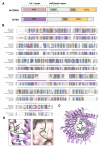The Role of the TSK/TONSL-H3.1 Pathway in Maintaining Genome Stability in Multicellular Eukaryotes
- PMID: 36012288
- PMCID: PMC9409234
- DOI: 10.3390/ijms23169029
The Role of the TSK/TONSL-H3.1 Pathway in Maintaining Genome Stability in Multicellular Eukaryotes
Abstract
Replication-dependent histone H3.1 and replication-independent histone H3.3 are nearly identical proteins in most multicellular eukaryotes. The N-terminal tails of these H3 variants, where the majority of histone post-translational modifications are made, typically differ by only one amino acid. Despite extensive sequence similarity with H3.3, the H3.1 variant has been hypothesized to play unique roles in cells, as it is specifically expressed and inserted into chromatin during DNA replication. However, identifying a function that is unique to H3.1 during replication has remained elusive. In this review, we discuss recent findings regarding the involvement of the H3.1 variant in regulating the TSK/TONSL-mediated resolution of stalled or broken replication forks. Uncovering this new function for the H3.1 variant has been made possible by the identification of the first proteins containing domains that can selectively bind or modify the H3.1 variant. The functional characterization of H3-variant-specific readers and writers reveals another layer of chromatin-based information regulating transcription, DNA replication, and DNA repair.
Keywords: DNA repair; DNA replication; genome stability; histone H3.1 variant; homologous recombination.
Conflict of interest statement
The authors declare that they have no competing interest.
Figures




References
Publication types
MeSH terms
Substances
Grants and funding
LinkOut - more resources
Full Text Sources

